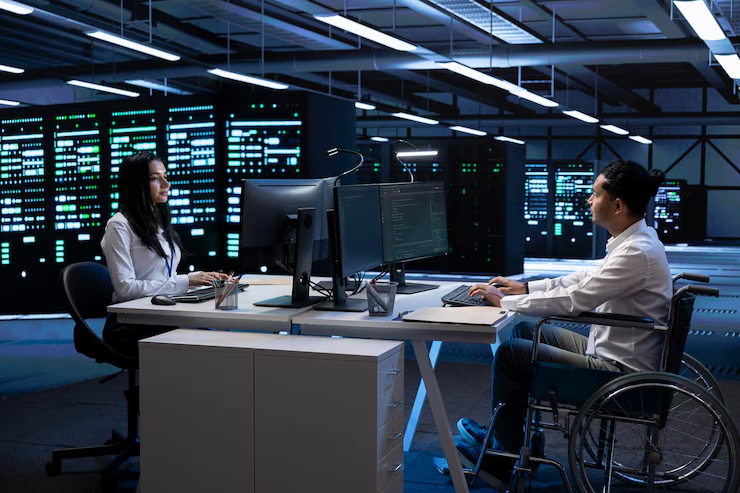Data Center Resilience – Ensuring Uptime Through Intelligent Infrastructure Management. Three months ago, I was woken at 2 AM by an alert on my phone. A cooling system in our east wing was showing anomalous behavior nothing critical yet, but our predictive system had detected a pattern that historically preceded failure. Instead of waiting for an actual outage, our automated systems had already begun migrating workloads while simultaneously scheduling maintenance. By the time I arrived on-site, the potential crisis had been averted without a single customer experiencing downtime.
This is the new face of data center resilience: intelligent infrastructure that doesn’t just respond to failures, but anticipates and prevents them.
Beyond the Five Nines
We used to celebrate “five nines” (99.999%) of availability as the gold standard allowing just 5.26 minutes of downtime per year. But in today’s interconnected world, even this isn’t enough for many applications:
- A three-minute financial trading platform outage could cost millions in lost transactions
- A healthcare system disruption could delay critical patient care decisions
- Smart city infrastructure downtime could cause gridlock or compromise public safety
The stakes have never been higher, which is why modern resilience strategies focus on zero perceived downtime not just impressive statistics.
The Intelligent Infrastructure Toolkit
Modern resilience is built on four technical pillars that work in concert:
- Distributed Environmental Intelligence
Instead of basic temperature sensors, we now deploy mesh networks of multimodal IoT devices that create a comprehensive digital twin of the physical environment. At one facility I manage, we use over 1,200 sensors that monitor:
- Thermal gradients across server rows with 0.3°C precision
- Power harmonics that can indicate degrading components
- Subtle changes in server fan acoustics that precede failure
- Air pressure differentials that might compromise cooling efficiency
These sensors don’t just record data they feed machine learning models that understand the subtle interplay between factors.
- Predictive Maintenance Orchestration
Modern DCIM (Data Center Infrastructure Management) platforms use predictive algorithms that identify failure patterns days or weeks before human operators would notice. The technical architecture typically includes:
- Time-series databases optimized for rapid pattern recognition
- Anomaly detection algorithms that establish dynamic baselines
- Reinforcement learning systems that improve with each prevented incident
- Automated workflow triggers that initiate precisely timed interventions
In one facility I consulted for, this approach reduced unplanned maintenance events by 78% year-over-year.
- Resilient Topology Design
Physical redundancy remains crucial, but it’s now intelligently managed. Modern data centers implement:
- Dynamic power routing that can shift loads within milliseconds
- N+1+1 redundancy for mission-critical systems (primary + two backup systems)
- Segment isolation architecture that contains failures like bulkheads in a ship
- Automated canary testing of redundant systems to ensure actual functionality
- Autonomous Recovery Systems
When incidents do occur, recovery is increasingly automated:
- Self-healing network fabrics that reroute traffic around failed nodes
- Containerized applications that automatically respawn on healthy infrastructure
- Geographically aware load balancing that factors in latency and regional health
- Transaction-level persistence that eliminates data loss during failovers
Smart Cities: The Ultimate Resilience Test
Working with smart city infrastructure has shown me that data center resilience isn’t just a technical challenge—it’s a public service obligation. When a data center supports traffic management systems or emergency services, resilience becomes a matter of public safety.
Consider the architecture we implemented for a midsize city’s smart infrastructure:
- Edge computing nodes with N+2 redundancy at critical intersections
- Real-time replication to regional micro data centers with <10ms latency
- Air-gapped emergency systems that can operate autonomously if central systems fail
- Predictive load balancing that anticipates traffic surges during public events
The Human Element in Automated Resilience
Despite the emphasis on automation, human expertise remains vital. The most resilient data centers I’ve worked with pair technical systems with:
- Chaos engineering teams that intentionally test failure scenarios
- Cross-functional response teams that train through simulation
- Continuous improvement processes that turn each incident into an enhancement
Looking Forward
The future of data center resilience will be defined by even greater autonomy and intelligence. We’re already seeing early implementations of:
- Self-optimizing infrastructures that continuously reconfigure for maximum resilience
- Digital twins that can simulate thousands of failure scenarios per second
- Machine learning systems that identify novel threat patterns before they manifest
Conclusion
As our digital dependencies deepen, data center resilience has evolved from a technical specification to a business imperative. Through intelligent infrastructure management, we’re moving toward a world where downtime becomes increasingly rare not because we’ve built perfect systems, but because we’ve built systems that adapt, predict, and heal themselves.
The true measure of resilience isn’t how quickly you recover from failure it’s how many potential failures you prevent before anyone notices. That shift from reactive to proactive management represents the future of our digital infrastructure.

